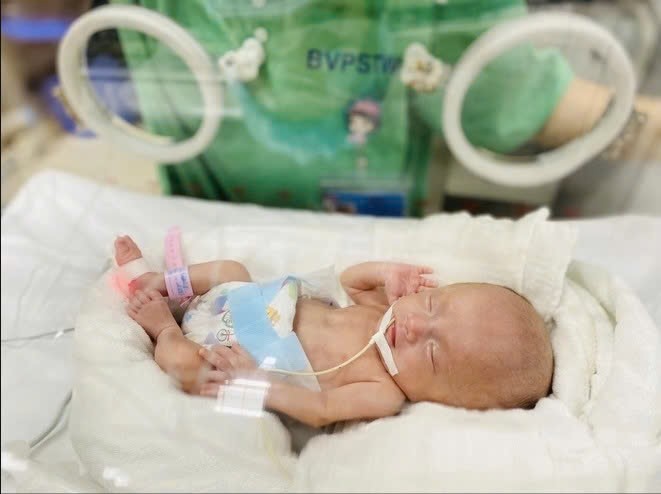Professor Nguyen Duy Anh, director of the National Hospital of Obstetrics and Gynecology, announced this at the hospital's 70th-anniversary celebration on 18/7. This is a leading class 1 hospital specializing in obstetrics and gynecology under the Ministry of Health.
"Babies once considered unable to survive are now, with continuous efforts and the application of advanced techniques, being saved by the thousands, bringing hope and happiness to many families," Professor Anh said.
About 10 years ago, the survival rate of babies born weighing less than 1,000 g was only about 58%; now, it has increased to 85%. Many babies born at 23-25 weeks of gestation are saved without any neurological or motor impairments. The hospital once nurtured a premature baby weighing only 400 g, considered a miracle of Vietnamese medicine. These achievements have contributed to reducing the overall neonatal mortality rate of the hospital to below 5% – a record low.
According to Professor Anh, to achieve this result, the hospital has applied and mastered the most advanced techniques in the world, improving the quality of treatment for premature babies. The hospital is the first unit in the country to successfully apply the non-invasive surfactant administration technique using two methods, LISA and INSURE, for extremely premature and low-birth-weight infants under 1,000 g – the group with the highest risk of death and serious complications.
The LISA (Less Invasive Surfactant Administration) method, also known as the minimally invasive surfactant delivery technique, treats respiratory distress in premature infants by delivering surfactant into the lungs through a small catheter without the need for endotracheal intubation. This method's advantages include reducing lung damage and complications associated with invasive mechanical ventilation, shortening hospital stays and treatment costs, and allowing for natural breathing, which helps the lungs develop better.
To date, the hospital has successfully treated nearly 3,000 premature babies using the LISA/INSURE technique, of which over 90% did not require endotracheal intubation, significantly reducing neonatal mortality due to severe respiratory failure. The rate of chronic lung disease and brain hemorrhage in newborns has decreased from 68% to 25%. The rate of bronchopulmonary dysplasia has decreased by more than 50% in premature infants weighing less than 1,500 g.
This technique has now been transferred to more than 40 medical facilities nationwide. The National Hospital of Obstetrics and Gynecology has been selected by the Ministry of Health as the national training center for non-invasive surfactant administration.
 |
A 400 g premature baby nurtured by the hospital. Photo: Hospital provided |
A 400 g premature baby nurtured by the hospital. Photo: Hospital provided
At the ceremony, Deputy Minister of Health Tran Van Thuan requested the hospital to continue investing in developing a team of obstetricians and gynecologists, scientists, educators, and healthcare administrators with a comprehensive vision and an integrated mindset. He encouraged promoting scientific research linked to clinical practice and technological breakthroughs in fetal medicine and neonatal care, using innovation as a driving force for development.
In addition, the hospital should build strategic partnerships with leading medical centers worldwide, forming a high-quality medical service model, aiming to develop specialized medical tourism in the field of reproductive healthcare.
On this occasion, the Deputy Minister awarded the Third-class Labor Order to the hospital, a collective, and 3 individuals. Five more doctors from the hospital were awarded the title of Meritorious Doctor.
Le Nga












